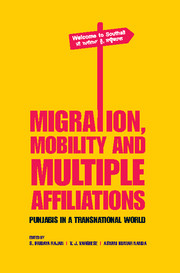Book contents
- Frontmatter
- Contents
- List of Tables and Figures
- Preface
- Acknowledgements
- Transnational World and Indian Punjab: Contemporary Issues
- Part I A Historical Survey
- Part II Shifting Contours of Migration
- 5 Ziddi Mundeh: Political Asylum, Transnational Movement and the Migrations of Men
- 6 Punjabi Illegal Migrants in France: Tales of Suffering, Invisibility and Marginalization
- 7 Migration as a Transnational Enterprise: Migrations from Eastern Punjab and the Question of Social Licitness
- Part III Social Structures and Organizational Links
- Part IV Education and Migration
- Part V Family Networks
- Contributors
- Index
6 - Punjabi Illegal Migrants in France: Tales of Suffering, Invisibility and Marginalization
from Part II - Shifting Contours of Migration
Published online by Cambridge University Press: 05 March 2016
- Frontmatter
- Contents
- List of Tables and Figures
- Preface
- Acknowledgements
- Transnational World and Indian Punjab: Contemporary Issues
- Part I A Historical Survey
- Part II Shifting Contours of Migration
- 5 Ziddi Mundeh: Political Asylum, Transnational Movement and the Migrations of Men
- 6 Punjabi Illegal Migrants in France: Tales of Suffering, Invisibility and Marginalization
- 7 Migration as a Transnational Enterprise: Migrations from Eastern Punjab and the Question of Social Licitness
- Part III Social Structures and Organizational Links
- Part IV Education and Migration
- Part V Family Networks
- Contributors
- Index
Summary
Introduction
Illegal migration from South Asia has so far elicited little research work: if one looks at recent publications on the Indian diaspora, for instance, the topic is hardly discussed. One reason is that researching and writing about illegal migration is not an easy task.
Firstly, it represents a highly politicized and contentious issue, both for the country of destination and the country of origin. Indeed, the Punjabi ‘kabooter’ (pigeons, i.e., illegal migrants) are the hidden face of the enterprising, professional, law-abiding Indian diaspora and constitute an embarrassing reality for the Indian state and its representatives abroad, such as Indian embassies.
Secondly, fieldwork in a context where fear and uncertainty dominate the life of informants is particularly challenging and calls for a variety of ethnographic practices and a great deal of self-reflexivity.
Nevertheless, the authors shall try and address the issue of Punjabi illegal migrants in France by first replacing Punjabi migration to France within the wider context of the presence of South Asians in this country, specifying the different phases of settlement, the patterns of socio-economic integration and the issues pertaining to ethno-religious identity.
The chapter will then introduce us to the Beaurepaire day care centre where they work and to the specific project for Punjabis that their NGO set up.
The chapter will finally discuss the consequences of clandestineness on these men, their strategy of invisibility and the double exclusion and marginalization they are submitted to with regards to the wider society but also to the local Punjabi community.
History of Sikh migration and settlement patterns in France
Sikh migration to France has taken place in three major waves. The first wave occurred in the late 1970s and early 1980s, when a few Sikhs arrived first in Germany and Belgium, and then later in France, as undocumented immigrants, because they could not reach the UK. These pioneers lacked any familiarity whatsoever with the host society, didn't speak a word of French and faced very tough living conditions, without permanent housing or job. Most of them benefited from the legalization procedure of the newly elected left-wing government in 1981–82 and could, therefore, move away from this absolute precariousness. They set up community institutions and networks, in particular the first gurdwara, which was created in 1986.
- Type
- Chapter
- Information
- Migration, Mobility and Multiple AffiliationsPunjabis in a Transnational World, pp. 156 - 171Publisher: Cambridge University PressPrint publication year: 2015
- 1
- Cited by



